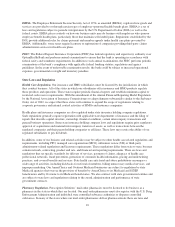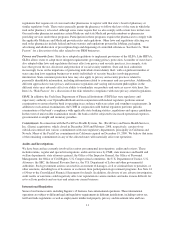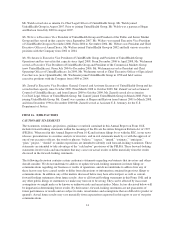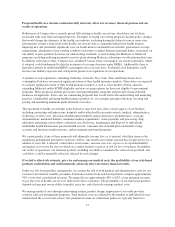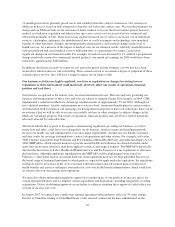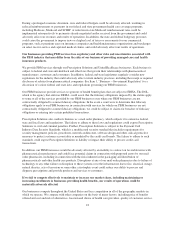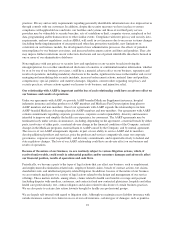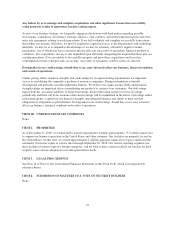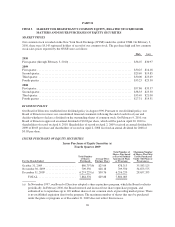United Healthcare 2009 Annual Report Download - page 18
Download and view the complete annual report
Please find page 18 of the 2009 United Healthcare annual report below. You can navigate through the pages in the report by either clicking on the pages listed below, or by using the keyword search tool below to find specific information within the annual report.12-month period and is generally priced one to four months before the contract commences. Our revenue on
Medicare policies is based on bids submitted in June the year before the contract year. We base the premiums we
charge and our Medicare bids on our estimates of future medical costs over the fixed contract period; however,
medical cost inflation, regulation and other factors may cause actual costs to exceed what was estimated and
reflected in premiums or bids. These factors may include increased use of services, increased cost of individual
services, catastrophes, epidemics, the introduction of new or costly treatments and technology, new mandated
benefits or other regulatory changes, insured population characteristics and seasonal changes in the level of
health care use. As a measure of the impact of medical costs on our financial results, relatively small differences
between predicted and actual medical costs or utilization rates as a percentage of revenues can result in
significant changes in our financial results. For example, if medical costs increased by 1% without a proportional
change in related revenues for commercial insured products, our annual net earnings for 2009 would have been
reduced by approximately $200 million.
In addition, the financial results we report for any particular period include estimates of costs that have been
incurred for which claims are still outstanding. These estimates involve an extensive degree of judgment. If these
estimates prove too low, they will have a negative impact on our future results.
Our business activities are highly regulated; new laws or regulations or changes in existing laws or
regulations or their enforcement could materially adversely affect our results of operations, financial
position and cash flows.
Our business is regulated at the federal, state, local and international levels. The laws and rules governing our
business and interpretations of those laws and rules are subject to frequent change. For example, in 2009, CMS
implemented a reduction in Medicare Advantage reimbursements of approximately 5% for 2010. Although we
have adjusted members’ benefits and premiums on a selective basis, terminated benefit plans in certain counties,
and intensified both our medical and operating cost management in response to these rate reductions, there can be
no assurance that we will be able to execute successfully on these or other strategies to address changes in the
Medicare Advantage program. Our results of operations, financial position and cash flows could be materially
adversely affected by such reductions.
The broad latitude that is given to the agencies administering regulations governing our business, as well as
future laws and rules, could force us to change how we do business, restrict revenue and enrollment growth,
increase our health care and administrative costs and capital requirements, and increase our liability in federal
and state courts for coverage determinations, contract interpretation and other actions. For example, in October
2008 Congress enacted the Paul Wellstone and Pete Domenici Mental Health Parity and Addiction Equity Act of
2008 (MHPAEA), which requires insurers to provide mental health and substance use disorder benefits under
terms that are no more restrictive than those applied to medical and surgical benefits. The MHPAEA specifically
directed the Secretaries of Labor, Health and Human Services and the Treasury to issue regulations to effectuate
the legislation. Although regulations regarding how the MHPAEA will be implemented were issued on
February 2, 2010 in the form of an interim final rule, final regulations have not yet been published. Because of
the broad range of treatment limitations to which parity is expected to apply under the regulations, the regulations
will likely lead to an increase in the costs associated with both insured and self-insured plans for behavioral
health benefits and services and impact our market for carve-out health benefit administration, which could have
an adverse effect on our earnings from operations.
We must also obtain and maintain regulatory approvals to market many of our products, to increase prices for
certain regulated products and to complete certain acquisitions and dispositions, including integration of certain
acquisitions. Delays in obtaining approvals or our failure to obtain or maintain these approvals could reduce our
revenue or increase our costs.
In August 2007, we entered into a multi-state national agreement with regulatory offices in 39 states and the
District of Columbia relating to UnitedHealthcare’s fully insured commercial business administered on the
16






